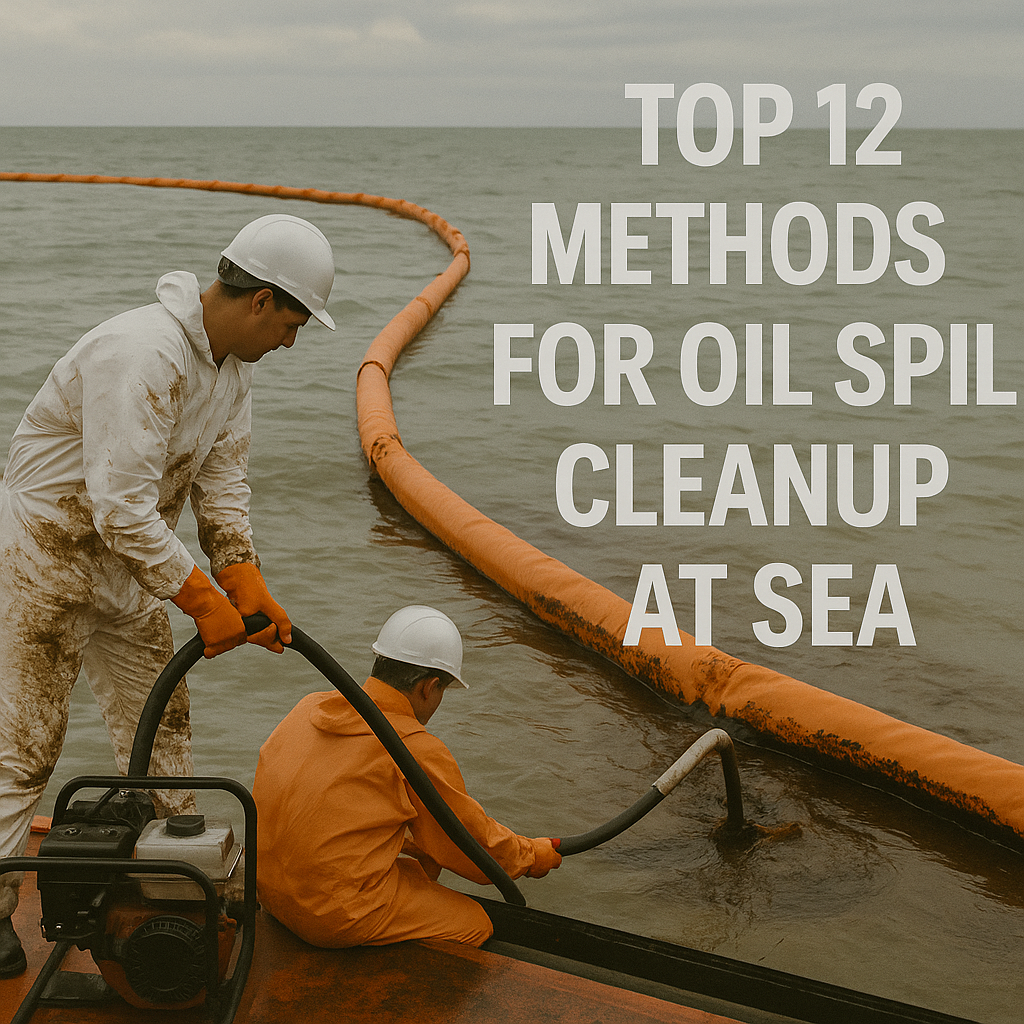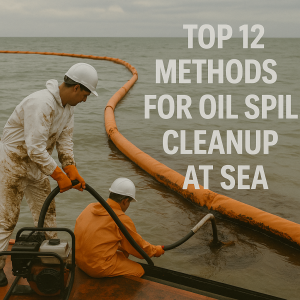Oil spills at sea pose serious environmental and economic threats worldwide. Discover the top 12 oil spill cleanup methods used by maritime professionals to protect marine ecosystems and coastal communities. Learn about emerging technologies, real-world applications, and best practices in this comprehensive guide.
Oil spills are among the most devastating marine environmental disasters, threatening biodiversity, coastal economies, and human health. Despite technological advancements and strict regulations under IMO and MARPOL, spills still occur, whether from shipping accidents, offshore drilling, or pipeline failures. The urgency of rapid, effective cleanup methods cannot be overstated, as the window to minimize ecological damage is often short. For seafarers, environmental specialists, and maritime students, understanding the variety of oil spill cleanup techniques is crucial. This knowledge not only supports preparedness and response but also fosters innovation in sustainable marine protection.
–
Why Oil Spill Cleanup Matters in Maritime Operations
Oil spills have immediate and long-term effects on marine life, fisheries, tourism, and human health. According to the International Maritime Organization (IMO), over 1.3 million tonnes of oil were spilled globally in the past decades, highlighting ongoing risks despite stricter controls (IMO Marine Environment Protection Committee, 2022).
Effective oil spill response reduces contamination of shorelines, protects vulnerable species, and supports rapid ecosystem recovery. Ports, shipping companies, and offshore operators invest heavily in spill contingency planning and technology adoption to comply with regulations like MARPOL Annex I and regional protocols.
1. Mechanical Containment and Recovery (Booms and Skimmers)
The most traditional and widely used approach involves containing the spill with floating barriers known as booms, preventing the spread of oil. Skimmers then recover the trapped oil from the water surface.
-
Booms come in various designs: containment booms form barriers, while deflection booms redirect oil to collection zones.
-
Skimmers include weir skimmers, oleophilic skimmers (oil-attracting surfaces), and suction skimmers.
This method is effective for calm waters but less so in rough seas or strong currents, where booms may fail to contain the slick.
Case Study: During the 2010 Deepwater Horizon spill, mechanical recovery was a first-line response but recovered only about 3% of the spilled oil due to challenging sea conditions (NOAA, 2011).
2. Chemical Dispersants
Dispersants are chemical agents sprayed over oil slicks to break oil into tiny droplets, enhancing natural biodegradation by microbes.
-
They reduce the surface tension of oil, allowing it to mix with water and dilute faster.
-
Aerial and vessel-based spraying are common application methods.
Dispersants can mitigate shoreline impact but may increase oil toxicity in the water column, potentially affecting marine organisms. Their use is carefully regulated and assessed case-by-case.
Recent Development: New eco-friendlier dispersants with lower toxicity profiles have been developed and tested under IMO guidelines (IMO MEPC Report, 2023).
3. In-situ Burning
This method involves controlled ignition of thick oil slicks to reduce the volume of spilled oil rapidly.
-
It requires sufficient oil thickness (usually above 2-3 mm) and calm weather conditions.
-
Burning converts oil into CO₂, water vapor, and residual ash.
While highly efficient in removing large oil quantities quickly, it produces air pollution and ash residue, requiring careful environmental trade-off considerations.
Example: The 1991 Gulf War oil spill response included in-situ burning, which removed significant oil volumes, though environmental impacts on air quality were noted (Science Direct, 1993).
4. Bioremediation
Bioremediation uses microorganisms or nutrients to accelerate the natural breakdown of oil hydrocarbons in water or sediments.
-
Microbes metabolize oil into harmless byproducts like carbon dioxide and water.
-
Nutrient fertilizers or oxygen releasers enhance microbial activity.
This eco-friendly method is often used in conjunction with other cleanup approaches, especially for shoreline remediation.
Case Study: The Exxon Valdez spill response included bioremediation to aid shoreline recovery, significantly reducing oil residues over months (EPA Report, 1994).
5. Sorbents
Sorbents are materials designed to absorb or adsorb oil from water surfaces.
-
They include natural materials (peat moss, straw), synthetic pads, and foams.
-
Sorbents are particularly useful for small spills or residual oil after mechanical recovery.
Their effectiveness depends on oil type, water conditions, and sorbent capacity.
6. Manual Cleanup
Manual cleanup involves trained personnel physically removing oil from beaches, rocks, and mangroves using tools like shovels and buckets.
-
Critical in sensitive habitats where machinery could cause damage.
-
Requires safety precautions due to toxic exposure.
Although labor-intensive, manual cleanup remains a backbone of shoreline oil spill response.
7. Vacuum Trucks and Portable Pumps
Vacuum trucks and pumps extract oil-water mixtures from collection points, especially nearshore and port areas.
-
They complement mechanical recovery and sorbent use.
-
Rapidly transfer recovered oil to storage tanks for treatment or disposal.
8. Solidifiers and Gelling Agents
These chemical agents transform liquid oil into a solid or gel, simplifying removal and reducing spread.
-
Solidifiers are applied directly onto the oil slick.
-
After solidification, oil can be collected mechanically or manually.
While innovative, their use is limited due to cost and operational complexity.
9. Skimming with Autonomous Systems and Drones
Recent advancements include autonomous surface vehicles (ASVs) and drone technology for oil spill detection and skimming.
-
ASVs can operate continuously in harsh environments.
-
Drones provide aerial monitoring, enabling rapid spill assessment.
This tech reduces risk to personnel and improves response speed.
10. Oil Water Separators
These systems separate recovered oil from seawater onboard recovery vessels or shore facilities.
-
Essential for processing collected mixtures and reducing environmental discharge.
-
Utilize gravity separation, centrifugation, or filtration.
Efficient oil-water separation enables recycling of recovered oil and cleaner water release.
11. Controlled Sedimentation
Sedimentation traps oil particles in specially designed basins or coastal areas to prevent spread.
-
Works mainly in contained areas like harbors.
-
Often combined with skimming or sorbents.
12. Phytoremediation
An emerging method involving plants that absorb or degrade hydrocarbons in coastal marshes and wetlands.
-
Natural and sustainable.
-
Limited to shoreline and estuarine environments.
–
Real-World Applications and Lessons Learned
The Deepwater Horizon (2010) and Exxon Valdez (1989) oil spills remain pivotal case studies. Both showcased the need for a multi-faceted response using mechanical recovery, dispersants, and bioremediation. They also highlighted challenges in coordination, environmental trade-offs, and long-term monitoring.
The 2021 Mauritius oil spill response demonstrated improved preparedness and faster deployment of mechanical and manual cleanup techniques, reflecting lessons learned from past incidents (UNEP Report, 2022).
Frequently Asked Questions (FAQ)
Q1: What is the fastest method to contain an oil spill at sea?
Mechanical containment with booms is typically the quickest initial response to limit spill spread.
Q2: Are chemical dispersants safe for marine life?
Dispersants help biodegrade oil but can increase toxicity in the water column; usage is carefully regulated.
Q3: Can oil spills be completely cleaned up?
Complete removal is challenging; cleanup aims to minimize environmental impact and accelerate natural recovery.
Q4: How does weather affect oil spill cleanup?
Rough seas, wind, and temperature influence method effectiveness and operational safety.
Q5: What international regulations govern oil spill response?
IMO’s MARPOL Annex I and regional agreements like OSPAR guide prevention and response.
Conclusion
Oil spill cleanup at sea demands a well-coordinated blend of traditional and innovative methods. From mechanical recovery to bioremediation and emerging autonomous technologies, each method offers unique benefits and constraints. Maritime professionals must stay informed on best practices and regulatory standards to safeguard marine ecosystems effectively.
Continued investment in research, training, and international collaboration will enhance global capabilities to respond swiftly and sustainably to oil spills, protecting the ocean that connects us all.
References
-
International Maritime Organization (IMO). MARPOL Annex I and Oil Spill Response. (2023). https://www.imo.org
-
National Oceanic and Atmospheric Administration (NOAA). Deepwater Horizon Oil Spill Response. (2011). https://response.restoration.noaa.gov
-
United Nations Environment Programme (UNEP). Mauritius Oil Spill Response and Lessons. (2022). https://www.unep.org
-
Environmental Protection Agency (EPA). Exxon Valdez Oil Spill Bioremediation. (1994). https://www.epa.gov
-
Science Direct. In-situ Burning in Oil Spill Cleanup. (1993). https://www.sciencedirect.com
-
Baltic Exchange. Green Shipping and Environmental Compliance. (2024). https://www.balticexchange.com



Your articles never fail to captivate me. Each one is a testament to your expertise and dedication to your craft. Thank you for sharing your wisdom with the world.
thank you
It¦s in point of fact a great and useful piece of info. I¦m glad that you shared this useful info with us. Please stay us informed like this. Thanks for sharing.
When I initially commented I clicked the -Notify me when new feedback are added- checkbox and now every time a remark is added I get four emails with the same comment. Is there any means you possibly can remove me from that service? Thanks!